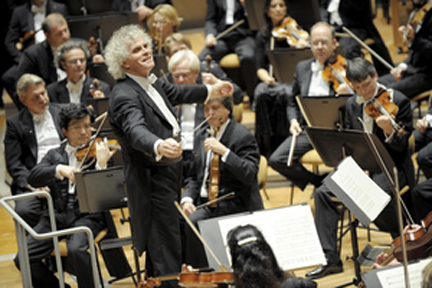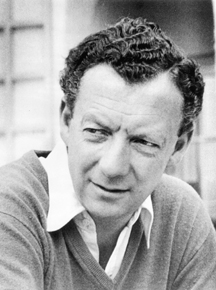By Robert D. Thomas
Music Critic
Southern California News Group
 Sir Simon Rattle led his Berlin Philharmoniker yesterday in Rénee and Henry Segerstrom Concert Hall in Costa Mesa. 2013 photo by Monika Ritterhaus.
Sir Simon Rattle led his Berlin Philharmoniker yesterday in Rénee and Henry Segerstrom Concert Hall in Costa Mesa. 2013 photo by Monika Ritterhaus.
___________________
My review of the Berlin Philharmonic’s concert Sunday in Costa Mesa, published online on the County Register’s Web site, is HERE. The story will run in the Register’s print editions tomorrow.
Following are some additional notes that fell on the cutting room floor:
• The BPO’s appearances in Walt Disney Concert Hall Saturday and Renée and Henry Segerstrom Concert Hall Sunday was part of a cross-continent tour that began in New York City’s Carnegie Hall on Nov. 9 and 10 and continued in Boston, Toronto and Ann Arbor, Michigan before heading to the west coast. The tour concludes tonight and tomorrow in San Francisco’s Davies Symphony Hall.
• The alternate tour program, which was played in Disney Hall, was equally challenging to that we heard Sunday: Pierre Boulez’s Éclat and Mahler’s Symphony No. 7.
• Sunday’s concert was the Berlin Philharmonic’s appearance in Orange County in 15 years. It came back then to the original Segerstrom Hall when Claudio Abbado led the ensemble in two all-Beethoven programs, featuring the third, fifth and sixth symphonies. This was also, of course, the BPO’s first time in Segerstrom Concert Hall, which is celebrating its 10th anniversary this season.
• The OC program booklet contained the longest set of music notes than I can ever remember, stretching more than seven pages (although, thankfully for us older folks, the Philharmonic Society of Orange County uses nice large type for its notes). The one paragraph about Brahms’ Symphony No. 2 was dwarfed by the copious notes on the three pre-intermission works: Six Pieces for Orchestra, Op. 6b, by Anton Webern, Arnold Schoenberg’s Five Pieces for Orchestra, Op. 16, and Three Pieces for Orchestra, Op. 6 by Alban Berg.
• The orchestra’s rehearsal schedule created some serious problems for the PSOC and Segerstrom Concert Hall. The orchestra’s desire to rehearse in the main auditorium right up to the concert time meant that the preconcert lecture by Christopher Russell had to be switched into a smaller room that didn’t have nearly enough seats to handle the crowds. I arrived five minutes after the posted start time and people were already standing around and behind the chairs. I suspect that more folks than usual came hoping to learn something about the first half of the program, only to be turned away.
Segerstrom isn’t alone in this type of problem. At least with BP Hall in Disney, people can stand on the balconies and hear the lecture, if necessary. The Dorothy Chandler Pavilion uses the second-floor lobby for its lectures and that has the capacity for extra seating, if necessary. Ambassador Auditorium has nothing other than the main hall with which to handle lectures. Offhand I can’t think of another hall that could deal with the problem that cropped up Sunday.
Moreover, Segerstrom Concert Hall has only minimal seating in its lobbies, a fact that was exacerbated by the light rain that was falling as folks were arriving. Sir Simon Rattle, the BPO’s chief conductor and artistic director, called it “British weather.” He should know. Rattle returns top his native England to become Music Director of the London Symphony beginning in 2017.
• PSOC President and Artistic Director John Magnum welcomed the orchestra by announcing that the Society is halfway to its goal of $10 million endowment campaign that will enhance the group’s programming efforts.
• The next orchestra on the PSOC series is the Taiwan Philharmonic, which appears on Dec. 12 with violinist Cho-Liang Lin. The program includes two works including a violin concerto by Taiwanese composer Tyzen Hsiao along with Tchaikovsky’s Symphony No. 5. Information: https://philharmonicsociety.org/
_______________________
(c) Copyright 2016, Robert D. Thomas. All rights reserved. Portions may be quoted with attribution.


